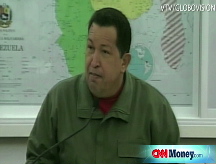Oil tumbles 12% on still-growing supply
Government report shows huge buildup in crude supplies, an additional sign that demand is falling.
NEW YORK (CNNMoney.com) -- Oil prices fell Wednesday in one of the biggest single-day declines in history, after a woeful supply report gave previously bullish investors little reason to believe oil would sustain a rally anytime soon.
U.S. crude for February delivery fell $5.95, or 12.3%, to settle at $42.63 a barrel, a day after soaring past $50 in intraday trading.
Wednesday's decline was the biggest percentage drop since Sept. 24, 2001, in a week of massive oil price drops following the Sept. 11 terrorist attacks.
Crude's decline nearly undid more than a week of gains that sent oil up from below $40.
Prices fell early in the day on dour economic news. The selloff accelerated dramatically after a government supply report showed still weakening demand for oil, dashing the bullish hopes of traders that had been betting on the beginning of another substantial rise in crude prices.
"For oil to make a real recovery, we will need to see a real economic rebound, not just talk about it," said Stephen Schork, editor of the industry publication The Schork Report. "Oil is still volatile and will likely fall below $30 a barrel again before it makes a material rise."
The Department of Energy report Wednesday showed crude stockpiles rose by a whopping 6.7 million barrels for the week ended Jan. 2. That far surpassed experts' forecast of a 1.5 million barrel rise, according to a poll by research firm Platts.
Rising supply suggests demand for fuel continues to plummet - a trend that has continued since the late summer, when gas prices began a steep and rapid decline from a mid-July record $4.114 a gallon.
The report also showed supplies of gasoline rose by 3.3 million barrels, while supplies of distillates, which are used to make diesel fuel and home heating oil, rose by 1.8 million barrels.
The Platts survey expected a gasoline supply increase of 1.6 million barrels, while stocks of distillates had been expected to rise by 700,000 barrels.
Crude prices had risen more than 38% since Christmas in very, very thin trading. Ultra-light trading volume meant bullish trades on tension in the Middle East and Russia, and further OPEC production cuts exacerbated the rise to $50.
"Many misread the rise over the past week on some kind of bogus assumption that the bottom arrived," said Schork. "The recent highs have been pushed around by low volume in the marketplace - virtually no one has been trading in the past two weeks."
Economy: Job losses rose more than 45% in December over the prior month, to 693,000, according to payroll firm ADP.
In addition, the number of announced job cuts last month was more than four times greater than in 2007, although down slightly from November, according to outplacement firm Challenger, Gray & Christmas.
Unemployment will continue to rise "significantly" into 2010, according to minutes from the Federal Reserve's December meeting, released late Tuesday. The Fed also said that the U.S. gross domestic product, a broad measurement of economic activity, will fall in 2009.
"It was a reminder of how bad the economy is," said Phil Flynn, senior market analyst with Alaron Trading in Chicago. "There's nothing about this financial crisis that bodes well for energy prices and energy demand."
The job reports and Fed's comments put investor attention squarely back on falling demand, a worry that has driven oil prices down from a record high of $147.27 a barrel last summer, according to Flynn.
Measuring supply: Oil production has started to show signs of slowing as low prices make both production and exploration less profitable.
"Traders are seeing producers put down rigs and scuttle projects, and that is a change that is real," Tom Orr, head of research for Weeden & Co., wrote in an e-mail. While the impact on the overall amount of oil entering the market is small, "it sends a signal to people that producers will put down projects very quickly," said Orr.
Last week, the number of oil and natural gas rigs in the United States searching for or pumping energy supplies fell by 5.7%, the largest decline in 15 years, according to oilfield service company Baker Hughes.
Furthermore, fighting in the Middle East between Israel and the Hamas-controlled Gaza Strip had sparked concerns that shipments to the West could be disrupted should an oil producing nation such as Iran get involved.
And an ongoing energy contract dispute in Eastern Europe led to a complete shutoff of natural gas shipments between Russia and Ukraine Wednesday, highlighting the region's reliance on the energy producer. The move could force more homes to switch from natural gas to heating oil for warmth during the winter months, according to Orr.
The United States and China also said last week that they would be adding to their respective strategic oil reserves and taking advantage of the sub-$50 price of oil.
Reports also emerged that Kuwait and Iran were taking concrete steps to comply with the Organization of Petroleum Exporting Countries' pledge to remove 2.2 million barrels a day from the market. ![]()




